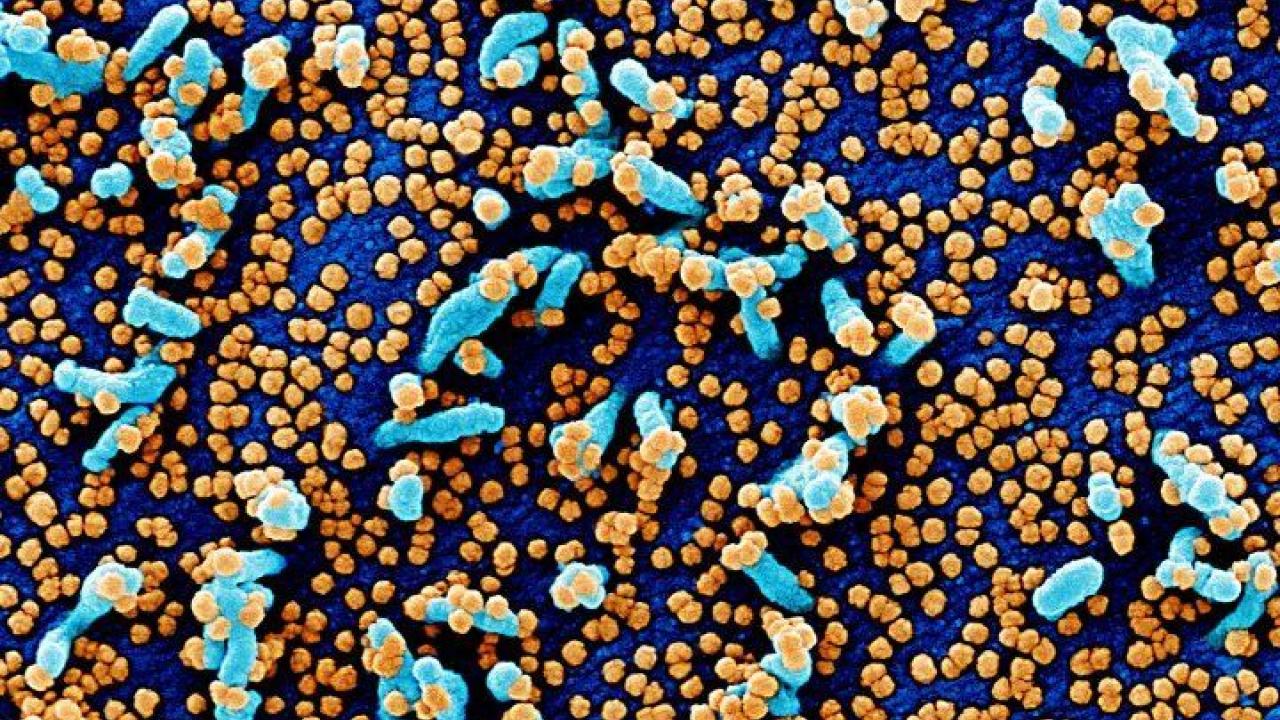
A colorized scanning electron micrograph shows cultured cells (blue) heavily infected with SARS-COV-2 virus particles (orange). Image by NIH.
UC San Francisco’s Nevan Krogan, PhD, hasn’t slept much since January, when cases of COVID-19 caused by a novel coronavirus began to spike in China, stoking fears of the ensuing global pandemic that has since affected more than 100 countries.
During those fateful weeks, Krogan, director of UCSF’s Quantitative Biosciences Institute (QBI) and professor of Cellular and Molecular Pharmacology, has been single-mindedly focused on one goal: understanding in depth how the SARS-CoV-2 virus that causes COVID-19 hijacks the machinery of human cells to perpetuate itself. That knowledge could lead the way to stopping the disease in its tracks.
Though many hopes are hanging on the development of a vaccine or drug that targets the virus directly, Krogan takes an unconventional approach: target the host – in other words, you.
Considering exactly how a virus infects its host reveals why Krogan, also a senior investigator at the UCSF-affiliated Gladstone Institutes, takes aim from this unusual direction. Viruses have great power to cause illness, but they also have a critical weakness: they’re unable to reproduce on their own and depend on the protein-making machinery of their hosts to propagate. It’s that weakness that Krogan sees as an efficient means to put the brakes on the runaway train of COVID-19, and maybe other diseases as well.
To infect us, the SARS-CoV-2 virus gets its genetic material into our cells and then co-opts our own proteins, reassigning them to the task of making millions of copies of itself. This tsunami of copied viruses ultimately kills cells, releasing virus particles that travel through the body to infect more cells or be spread to new human hosts, perpetuating the outbreak.
Hunting for the Protein Interactions
After a round-the-clock, two-month process, Krogan identified more than 300 human proteins that interact with SARS-CoV-2 during infection. To do this, members of his lab looked at all 29 genes in the SARS-CoV-2 genome and sorted out the protein products of 26 of them. Then they cloned these proteins, added tiny chemical tags to them, and put them in human cells. The human proteins that interacted with viral ones could be identified by the chemical tags. The team compiled this information into a library of human proteins that enable the virus to replicate in our bodies.
Based on this information, Krogan and colleagues made a map of this “interactome,” laying out a network diagram showing how our proteins cooperate with viral ones. Blocking these interactions may prevent the virus from making copies of itself, Krogan reasons, thereby slowing down both infection and transmission.
Searching for Drugs
To identify the drugs that might accomplish this end, in a matter of days Krogan assembled a scientific coalition, dubbed the QBI Coronavirus Research Group, or QCRG, which includes hundreds of scientists at UCSF and elsewhere. Because scientists with federal grants cannot pivot quickly to another research area without some other form of financial support, longtime UCSF donor Ron Conway jumped into the breach, directing some of his own funds to QCRG and quickly rounding up a group of other philanthropists, as well as promoting the promising work on social media. To date, more than 40 others have responded with donations to the cause.
With Conway’s support, QCRG scientists, including a group of experts in drug discovery and development, took the new protein map and ran with it, in a search for potential treatments.
One such scientist, Kevan Shokat, PhD, a chemist and expert in drug design, is combing through databases of drug structures to find candidates that match up well with the human host proteins in the SARS-CoV-2 interactome, and therefore might block the actions of the virus. Shokat, UCSF professor of Cellular and Molecular Pharmacology, recruited other labs in his orbit to work on this question.